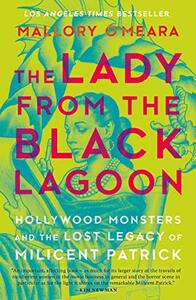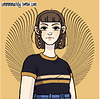Take a photo of a barcode or cover
837 reviews for:
The Lady from the Black Lagoon: Hollywood Monsters and the Lost Legacy of Milicent Patrick
Mallory O'Meara
837 reviews for:
The Lady from the Black Lagoon: Hollywood Monsters and the Lost Legacy of Milicent Patrick
Mallory O'Meara
I’ve had makeup artists to look up to, but until Mallory O’Meara gave me the story of Milicent Patrick I’ve never had a hero before. The book is both inspiring and achingly frustrating as Mallory recounts the life of Milicent, her search for the story of this female monster maker, and the harassment she and Millicent have faced in the moviemaking industry.
The book is wonderfully conversational and funny, people kept asking what I was laughing at while I was reading. I also absolutely cried a couple times.
Milicent Patrick was a groundbreaking woman, and I’m so grateful to Mallory for giving a voice to a woman who was forced to remain in the shadows so that all her achievements can finally be known. I’m never going to stop looking for the monster girls. I am one.
The book is wonderfully conversational and funny, people kept asking what I was laughing at while I was reading. I also absolutely cried a couple times.
Milicent Patrick was a groundbreaking woman, and I’m so grateful to Mallory for giving a voice to a woman who was forced to remain in the shadows so that all her achievements can finally be known. I’m never going to stop looking for the monster girls. I am one.
3.75*
a really fascinating look at not only the history of a woman who wasn’t credited as being the most influential monster makeup artists in Hollywood for her creation of the creature from the black lagoon, but also early Hollywood and Disney. really fascinating history about visual effects, makeup artists, and even Hearst Castle.
i did find the writing to be pretty simplistic and very repetitive and it took me a while to get through it because of that(even though the content was interesting). i basically skimmed the last half of it, not because it wasn’t interesting (in fact, because we get the meat and potatoes of Milicent’s life during the actual conception and aftermath of the film, it’s arguably the most interesting part of her life and what she’s known for) but because it felt like it was filled with too much of the same thing, it was honestly....boring. the anecdotes, if that’s the right word, about female representation being important IS important to conclude, but i found that O’Meara more often then not went on random tangents about it more than necessary.
about Milicent herself, she had such a fascinating and unique life, warts and all. i’m glad i was able to get to know her, from everything to her flaws to the highlights of her career.
this is O’Meara’s passion project and i can’t imagine anyone else writing such an interesting story about Milicent patrick. it’s also her first book and it’s made very evident. would recommend to anyone interested in women roles in early Hollywood and anyone interested in film horror history.
a really fascinating look at not only the history of a woman who wasn’t credited as being the most influential monster makeup artists in Hollywood for her creation of the creature from the black lagoon, but also early Hollywood and Disney. really fascinating history about visual effects, makeup artists, and even Hearst Castle.
i did find the writing to be pretty simplistic and very repetitive and it took me a while to get through it because of that(even though the content was interesting). i basically skimmed the last half of it, not because it wasn’t interesting (in fact, because we get the meat and potatoes of Milicent’s life during the actual conception and aftermath of the film, it’s arguably the most interesting part of her life and what she’s known for) but because it felt like it was filled with too much of the same thing, it was honestly....boring. the anecdotes, if that’s the right word, about female representation being important IS important to conclude, but i found that O’Meara more often then not went on random tangents about it more than necessary.
about Milicent herself, she had such a fascinating and unique life, warts and all. i’m glad i was able to get to know her, from everything to her flaws to the highlights of her career.
this is O’Meara’s passion project and i can’t imagine anyone else writing such an interesting story about Milicent patrick. it’s also her first book and it’s made very evident. would recommend to anyone interested in women roles in early Hollywood and anyone interested in film horror history.
I listened to this book on audible and I love that Mallory was the narrator, it was like having a fun conversation with my favorite podcaster about a topic she’s really passionate about and I learned some really cool information! Millicent Patric should be more well known and I hope this brings her to the light
emotional
informative
inspiring
reflective
tense
fast-paced
3.5 stars
I picked up this book because I'm a fan of Mallory and her podcast Reading Glasses. Had it not been for that I probably would've DNF'd this book.
This isn't a memoir about Milicent Patrick, it's about how O'Meara researched Milicent Patrick’s life. Its start is slow-paced as we learn about Milicent's father, William Randolph Hearst and his architect Julia Morgan, Nelbert Chouinard, the Westmores, and a history of special effects and makeup in the film industry. Being introduced to so much history before getting to Milicent was monotonous, offputting, and where I wanted to DNF the book (around 30% in the audiobook). Pushing through and getting to Milicent Patrick's story was rewarding. O'Meara did a great job of detailing what Milicent experienced in the film industry and her later life after special effects. I also enjoyed how Milicent's experience was connected to present-day women's experience in the film industry and the Me Too movement. Overall, I really enjoyed learning about Milicent Patrick but I think the story would be drastically more enjoyable had O'Meara not constantly compared her life to Milicent's. I look forward to seeing what Mallory writes next and how her writing style evolves.
I picked up this book because I'm a fan of Mallory and her podcast Reading Glasses. Had it not been for that I probably would've DNF'd this book.
This isn't a memoir about Milicent Patrick, it's about how O'Meara researched Milicent Patrick’s life. Its start is slow-paced as we learn about Milicent's father, William Randolph Hearst and his architect Julia Morgan, Nelbert Chouinard, the Westmores, and a history of special effects and makeup in the film industry. Being introduced to so much history before getting to Milicent was monotonous, offputting, and where I wanted to DNF the book (around 30% in the audiobook). Pushing through and getting to Milicent Patrick's story was rewarding. O'Meara did a great job of detailing what Milicent experienced in the film industry and her later life after special effects. I also enjoyed how Milicent's experience was connected to present-day women's experience in the film industry and the Me Too movement. Overall, I really enjoyed learning about Milicent Patrick but I think the story would be drastically more enjoyable had O'Meara not constantly compared her life to Milicent's. I look forward to seeing what Mallory writes next and how her writing style evolves.
✹ instagram ✹ #mostlybooksandcoffee ✹
challenging
emotional
inspiring
slow-paced
3.5 Stars
Overall, I really enjoyed this book once I got through the first 100 pages.
I went into this book thinking it was going to be more a biography of Milicent Patrick and less a memoir of Mallory O'Meara's relationship to Milicent's legacy. So, for the first 100 pages, I was really frustrated with all the interjections from O'Meara. Plus, it became really clear that there simply wasn't enough information out there about Milicent's early life, which made the first few chapters seemed stuffed with filler about William Randolph Hearst. This became even more glaring in the chapter which discusses Milicent's work at Disney, in which O'Meara skips over large chunks of Disney's life, because he is a famous man whose life is well documented and those parts of his life don't have anything to do with Milicent. It was the right call, but it left me wondering why we had so many pages describing how William Randolph Hearst made his money.
That being said, after the first 100 pages (almost exactly- my first positive annotation is at page 101), this book really changed for me. Milicent's life became much more full, and she was taking artistic jobs, which allowed O'Meara to write about film and animation history, rather than the history of one very rich eccentric man. More than that, though, I started to really appreciate O'Meara's voice and really enjoy the more memoir-y parts of the book. Once she started making connections between their lives, and the lives of all women who work in male-dominated industries, I started to get invested in the story of Milicent's life for the first time. She wasn't just surrounded by interesting people, she was an interesting person herself. By the end, I was laughing and crying and wanting to go out and watch a lot of classic monster movies.
My biggest gripe with this book, though, is the lack of proper citations. Absolutely nothing is cited in the entire book. This is especially frustrating given 1. so much of Milicent's life was purposely obfuscated both by Milicent herself and by Bud Westmore and 2. there is a lot of information in this book about how people felt about things, and the motivations behind specific actions. There are times when "proof" is alluded to (I'm thinking specifically of the reference to inter-office memos about Bud Westmore at Universal, and people in the publicity department knowing he was a bad guy) but since there are no citations, I have no idea what is verifiable and what is speculation. In the afterword, O'Meara specifically says that she didn't put anything in this book that she couldn't verify, but she is also not a historian, and is not versed in historical research, so I have no idea what she considers verifiable proof. Interviews? Undated photographs? Commercial publications? Personal papers? I have no idea, so I'm left with a really unclear understanding of where any of this information came from. Its a real big bummer, and something that frustrated me throughout the book, not because I didn't believe what O'Meara was saying and needed proof, but because knowing where the information comes from just makes it seem more solid and real to me as a historian.
Make no mistake, this book is not written for or by historians or biographers. It does not follow a lot of the "rules" of these genres, and really should be read more like a memoir. But, if you can get through the first 100 pages to the real meat of the story, O'Meara's passion both for Milicent and for monster girls in general, really makes it worth reading.
Overall, I really enjoyed this book once I got through the first 100 pages.
I went into this book thinking it was going to be more a biography of Milicent Patrick and less a memoir of Mallory O'Meara's relationship to Milicent's legacy. So, for the first 100 pages, I was really frustrated with all the interjections from O'Meara. Plus, it became really clear that there simply wasn't enough information out there about Milicent's early life, which made the first few chapters seemed stuffed with filler about William Randolph Hearst. This became even more glaring in the chapter which discusses Milicent's work at Disney, in which O'Meara skips over large chunks of Disney's life, because he is a famous man whose life is well documented and those parts of his life don't have anything to do with Milicent. It was the right call, but it left me wondering why we had so many pages describing how William Randolph Hearst made his money.
That being said, after the first 100 pages (almost exactly- my first positive annotation is at page 101), this book really changed for me. Milicent's life became much more full, and she was taking artistic jobs, which allowed O'Meara to write about film and animation history, rather than the history of one very rich eccentric man. More than that, though, I started to really appreciate O'Meara's voice and really enjoy the more memoir-y parts of the book. Once she started making connections between their lives, and the lives of all women who work in male-dominated industries, I started to get invested in the story of Milicent's life for the first time. She wasn't just surrounded by interesting people, she was an interesting person herself. By the end, I was laughing and crying and wanting to go out and watch a lot of classic monster movies.
My biggest gripe with this book, though, is the lack of proper citations. Absolutely nothing is cited in the entire book. This is especially frustrating given 1. so much of Milicent's life was purposely obfuscated both by Milicent herself and by Bud Westmore and 2. there is a lot of information in this book about how people felt about things, and the motivations behind specific actions. There are times when "proof" is alluded to (I'm thinking specifically of the reference to inter-office memos about Bud Westmore at Universal, and people in the publicity department knowing he was a bad guy) but since there are no citations, I have no idea what is verifiable and what is speculation. In the afterword, O'Meara specifically says that she didn't put anything in this book that she couldn't verify, but she is also not a historian, and is not versed in historical research, so I have no idea what she considers verifiable proof. Interviews? Undated photographs? Commercial publications? Personal papers? I have no idea, so I'm left with a really unclear understanding of where any of this information came from. Its a real big bummer, and something that frustrated me throughout the book, not because I didn't believe what O'Meara was saying and needed proof, but because knowing where the information comes from just makes it seem more solid and real to me as a historian.
Make no mistake, this book is not written for or by historians or biographers. It does not follow a lot of the "rules" of these genres, and really should be read more like a memoir. But, if you can get through the first 100 pages to the real meat of the story, O'Meara's passion both for Milicent and for monster girls in general, really makes it worth reading.
I am not a horror fan and think I've watched Creature from the Black Lagoon maybe once. That being said, I picked up this book because it kept being recommended to me on the library app and I figured why not. This book was not what I expected. I expected a straight forward bibliography about a badass creator. And yes I got a story about the badass creator of the Creature but I also got a fascinating look at the building of Hearst Castle, a look at early Hollywood, and a dedicated amateur researchers journey to find out what happened to a beloved creator.
Though not the biography I initially expected, this story told me so much more than I was expecting. O'Meara's story takes you on her journey to discover the complexity of the little known Millicent Patrick, who had a most interesting life. From Disney animator to monster designer to interior decorator, Millicent was one of a kind and I am glad I know who she is.
Though not the biography I initially expected, this story told me so much more than I was expecting. O'Meara's story takes you on her journey to discover the complexity of the little known Millicent Patrick, who had a most interesting life. From Disney animator to monster designer to interior decorator, Millicent was one of a kind and I am glad I know who she is.
informative
inspiring
medium-paced
informative
slow-paced







